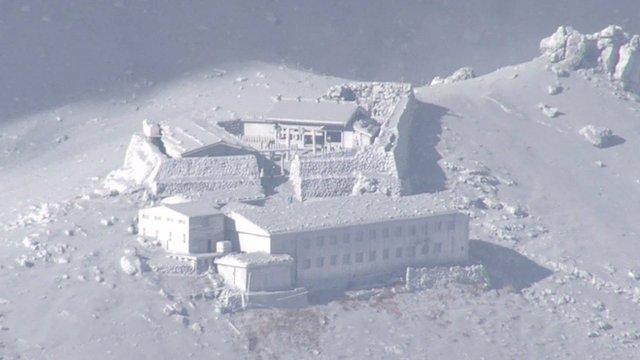Japan volcano: Mt Ontake rescue teams find 31 bodies
- Published
Survivors filmed the eruption at close quarters and described volcanic rock falling "like hailstones"
The bodies of 31 hikers have been found near the top of Japan's Mount Ontake a day after a sudden volcanic eruption.
The hikers were not breathing and their hearts had stopped. The search for a total of 45 missing climbers has now been called off for the night.
The volcano, about 200km (125 miles) west of Tokyo, erupted without warning on Saturday, spewing ash and rocks.
About 250 people were trapped on the slopes of the popular beauty spot, but most got down safely.
Japan is one of the world's most seismically active nations - but there have been no fatalities from volcanic eruptions since 1991, when 43 people died at Mount Unzen in the south-west.
First deaths confirmed
Saturday's eruption forced many of those on the mountain to make emergency descents through clouds of volcanic ash and falling rocks.
"The volcanic rocks fell like hailstones," one man said.
Eyewitnesses and helicopters caught dramatic images of the eruption
"We couldn't breathe so we covered our mouths with towels. We couldn't open our eyes either."
Another told reporters: "The volcanic ash was hurtling so fast I couldn't run away. I'm worried about people still on the mountain."
Almost 50 people were thought to have stayed on the mountain on Saturday night, reports said.
Rescue efforts will resume on Monday after an intense search on Sunday was called off because of toxic volcanic gases in the area.
It is understood 45 people are still listed as unaccounted for - including those found near the summit. There are fears that others could be buried under volcanic ash.
Four people were transported back down the mountain on Sunday and later confirmed dead, Japan's NHK News reported.
Japanese officials can only announce deaths after a formal doctor's examination.

Analysis: Rupert Wingfield-Hayes, BBC News, Tokyo
The question many people have been asking is - why were there hundreds of people on top of an active volcano? And, why was there no warning it was about to erupt?
The answer to the first question is that there are lots of active volcanos in Japan, and people hike on them all the time. I have done so myself. Mount Fuji is classed as an active volcano, and hundreds of thousands of people climb it every year.
In some ways the people caught in Saturday's eruption were very unlucky. It was a beautiful sunny Saturday at the peak of the autumn hiking season. Had it been a rainy Wednesday in June the chances are very few people would have been up there.
The question of no warning is harder to answer. Volcanologists point out this was a relatively small eruption, and that it was driven by super-heated steam and ash, not by lava being ejected from the magma chamber. That made it much more difficult to predict.
But it also meant that many of those caught up in the eruption survived. Had it been a large-scale eruption (like the one in 1979) with large pyroclastic flows, many more would have been killed.


Climbers caught in the ash cloud on Saturday raced down the mountain

Those brought down were taken to the town of Kiso for urgent medical help

The eruption continued under clear blue skies on Sunday

Residents over a large area have been warned of the risk of falling stones
Lodge sanctuary
The sudden eruption on Saturday was described as "like thunder" by one woman who runs a lodge near the summit.
Heavy, toxic volcanic ash up to 20cm (8in) thick covered much of the mountain, reports said.
"All of a sudden ash piled up so quickly that we couldn't even open the door," Shuichi Mukai, who worked in a mountain lodge just below the peak, told Reuters.
"We were really packed in here, maybe 150 people. There were some children crying, but most people were calm. We waited there in hard hats until they told us it was safe to come down."
Ordinarily Mount Ontake is a popular place to see autumn foliage.
Its peak is 3,067m (10,120ft) high and the mountain is a popular hiking route, dotted with lodges, cabins and well-marked trails.

The colours on Mount Ontake are usually a big draw for walkers at this time of year

- Published27 September 2014
